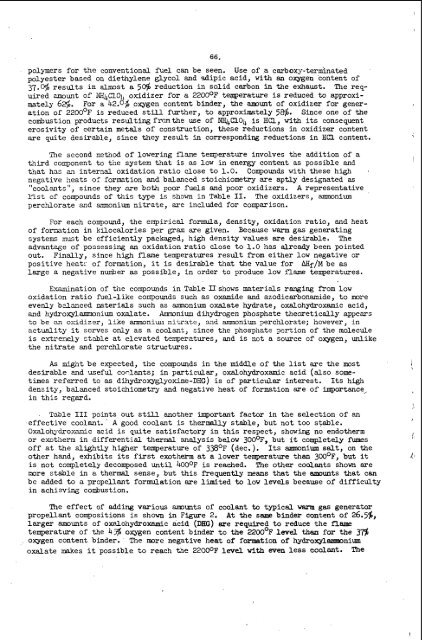secondary cells with lithium anodes and immobilized fused_salt
secondary cells with lithium anodes and immobilized fused_salt
secondary cells with lithium anodes and immobilized fused_salt
You also want an ePaper? Increase the reach of your titles
YUMPU automatically turns print PDFs into web optimized ePapers that Google loves.
polymers for the conventional fuel can be seen. Use of a carboxy-termhated<br />
polyester based on diethylene aycol <strong>and</strong> sdipic acid, <strong>with</strong> an owen content of<br />
37.odp results in almost a 50$ reduction in solid carbon in the exhaust. The required<br />
mount of IfH4ClO1 oxidizer for a 220OoF temperature is reduced to approximately<br />
66. For a 42.d$ oxygen content binder, the wunt of oxidizer for generation<br />
of 2200°F is reduced still further, to approximately 58%. Since one of the<br />
combustion products resultingfromthe use of NH4ClO4 is Ha, <strong>with</strong> its consequent<br />
erosivity of certain metals of construction, these reductions in oxidizer content<br />
are quite desirable, since they result in corresponding reductions in HCl content.<br />
The second nethod of lowering flame temperature involves the addition of a<br />
third component to tie system that is as low in energy content as possible <strong>and</strong><br />
that has a? internal oxidation ratio close to 1.0. Compounds <strong>with</strong> these high '<br />
negative heats of formation <strong>and</strong> balanced stoichiometry are aptly designated as<br />
66.<br />
"coolants", since they are both poor fuels <strong>and</strong> poor oxidizers.<br />
A representative<br />
l'ist of compounds of this type is shown in Table 11. The oxidizers, ammonium<br />
perchlorate <strong>and</strong> ammonium nitrate, are included for comparison.<br />
For each compound, the empirical formula, density, oxidation ratio, <strong>and</strong> heat<br />
of fomtion in kilocalories per gram are given. Because warm gas generating<br />
systems mt be efficiently packaged, high density values axe desirable. The<br />
advantGe of possessing an oxidation ratio close to 1.0 has already been pointed<br />
out. Finally, since high flame temperatures result from either low negative or<br />
positive heat:' of formation, it is desirable that the value for &/M be as<br />
large a negative nunber as possible, in order to produce low flame temperatures.<br />
Exanination of tie compounds in Table II shows materials ranging from low<br />
oxidation ratio fuel-like compounds such as oxamide <strong>and</strong> azodicarbonanide, to more<br />
evenly bilxced materials such as armnonium oxalate hydrate, oxalohydroxamic acid,<br />
<strong>and</strong> hydroxylamonium oxalate. Ammonium dihydrogen phosphate theoretically appears<br />
to be zr~ osidizcr, like arsnoniurn nitrate, <strong>and</strong> ammonium perchlorate; however, in<br />
actaity it serves only as a coolant, since the phosphate portion of the molecule<br />
is extrenely stable at elevated temperatures, <strong>and</strong> is not a source of oxygen, unlike<br />
the nitrate <strong>and</strong> perchlorate structures.<br />
As might be expected, the compounds in the middle of the list are the most<br />
desirable end useful corlants; in particular, oxalohydroxamic acid (also sometimes<br />
referred to as dihydroxyglyoxime-DHG) is of particular interest. Its high<br />
density, bzlanced stoichiometry <strong>and</strong> negative heat of formation are of importance,<br />
in this regard.<br />
Table I11 points out still another important factor in the selection of an<br />
effective coolant.. A good coolant is thermally stable, but not too stable.<br />
0xalohydrom.nic acid is quite satisfactory in this respect, sharing no endotherm<br />
or exotherm in differential thermal analysis below 300°F, but it completely fumes<br />
off at the slightly higher temperature of 338OF (dec.). Its arrrmonium <strong>salt</strong>, on the<br />
other h<strong>and</strong>, exhibits its first exotherm at a lower temperature than 30O0F, but it<br />
is not completely decomposed until 400°F is reached. The other coolants shown are<br />
mre stable in e thermal sense, but this fYequently means that the amounts that can<br />
be added to a propellant formulation are limited to low levels because of difficulty<br />
in achieving combustion.<br />
The effect of adding various aJmunts of coolant to typical warm gas generator<br />
propellant compositions is shown in Figure 2. At the same binder content of 26.58,<br />
larger amounts of oxalohydroxamic acid (DEG) are required to reduce the flame<br />
temperature of the 4% oxygen content binder to the 2200'F level then far the 3'7%<br />
oxygen content binder. !&e mre negative heat of formation of hydroxylanrmonium<br />
oxalate makes it possible to reach the 22000F level <strong>with</strong> even less coolant. The

















